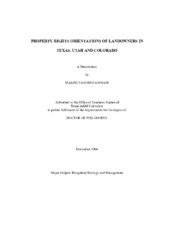| dc.contributor.advisor | Kreuter, Urs P. | |
| dc.creator | Nair, Malini Vasudevan | |
| dc.date.accessioned | 2005-02-17T21:05:28Z | |
| dc.date.available | 2005-02-17T21:05:28Z | |
| dc.date.created | 2004-12 | |
| dc.date.issued | 2005-02-17 | |
| dc.identifier.uri | https://hdl.handle.net/1969.1/1561 | |
| dc.description.abstract | The debate over allocation of rangeland resources has gained increasing momentum in the 1990’s. These days, several constraints are facing landowners, including high estate taxes, reduced profit margins of agricultural/ranching operations and increased legal restrictions in land use. Previous studies point out to strong private property rights among landowners, which have often been assumed to lead to short-term land management goals that are not particularly beneficial to society. This study analyses the multidimensionality of property rights and how this determines the variation in willingness to undertake various ecologically sustainable management practices without compensation and the variation in the perception of threats by the landowner.
A study was conducted on randomly selected landowners in three states, Texas, Utah and Colorado in 2001; an average response rate of 51.3% was obtained across all three states.
A descriptive analysis was conducted, tabulating the identifying characteristics of the respondent rancher/farmer and their property, their opinion regarding the rights and responsibilities of landowner, their likely willingness to implement different management practices and threats to the future viability of their ranching operation, searching for testable hypotheses.
In analysis of effect of multidimensionality of property rights on the willingness to undertake management practices without compensation, results confirmed the significance of three property rights except the individual property rights scale.
Respondent’s perception of the threats to the future viability of future operation was analyzed using directed acyclic graphs (DAG). The DAG revealed several directed edges (causal effects), but the presence of several bi-directed edges (cause and effect being indeterminable) were also identified. The subsequent regression analysis showed no significant property rights scales, but component analyses identified a few significant property rights orientations. The low significance is attributed to the presence of bi-directed edges. | en |
| dc.format.extent | 1198949 bytes | en |
| dc.format.medium | electronic | en |
| dc.format.mimetype | application/pdf | |
| dc.language.iso | en_US | |
| dc.publisher | Texas A&M University | |
| dc.subject | Property Rights Orientations | en |
| dc.subject | management practices | en |
| dc.subject | threats to landowners | en |
| dc.subject | causal analysis | en |
| dc.title | Property rights orientations of landowners in Texas, Utah and Colorado | en |
| dc.type | Book | en |
| dc.type | Thesis | en |
| thesis.degree.department | Rangeland Ecology and Management | en |
| thesis.degree.discipline | Rangeland Ecology and Management | en |
| thesis.degree.grantor | Texas A&M University | en |
| thesis.degree.name | Doctor of Philosophy | en |
| thesis.degree.level | Doctoral | en |
| dc.contributor.committeeMember | Smeins, Fred E. | |
| dc.contributor.committeeMember | Davis, George C. | |
| dc.contributor.committeeMember | Conner, J. Richard | |
| dc.type.genre | Electronic Dissertation | en |
| dc.type.material | text | en |
| dc.format.digitalOrigin | born digital | en |


